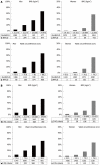Identification of individuals with non-alcoholic fatty liver disease by the diagnostic criteria for the metabolic syndrome
- PMID: 22509083
- PMCID: PMC3319947
- DOI: 10.3748/wjg.v18.i13.1508
Identification of individuals with non-alcoholic fatty liver disease by the diagnostic criteria for the metabolic syndrome
Abstract
Aim: To clarify the efficiency of the criterion of metabolic syndrome to detecting non-alcoholic fatty liver disease (NAFLD).
Methods: Authors performed a cross-sectional study involving participants of a medical health checkup program including abdominal ultrasonography. This study involved 11 714 apparently healthy Japanese men and women, 18 to 83 years of age. NAFLD was defined by abdominal ultrasonography without an alcohol intake of more than 20 g/d, known liver disease, or current use of medication. The revised criteria of the National Cholesterol Education Program Adult Treatment Panel III were used to characterize the metabolic syndrome.
Results: NAFLD was detected in 32.2% (95% CI: 31.0%-33.5%) of men (n = 1874 of 5811) and in 8.7% (95% CI: 8.0%-9.5%) of women (n = 514 of 5903). Among obese people, the prevalence of NAFLD was as high as 67.3% (95% CI: 64.8%-69.7%) in men and 45.8% (95% CI: 41.7%-50.0%) in women. Although NAFLD was thought of as being the liver phenotype of metabolic syndrome, the prevalence of the metabolic syndrome among subjects with NAFLD was low both in men and women. 66.8% of men and 70.4% of women with NAFLD were not diagnosed with the metabolic syndrome. 48.2% of men with NAFLD and 49.8% of women with NAFLD weren't overweight [body mass index (BMI) ≥ 25 kg/m(2)]. In the same way, 68.6% of men with NAFLD and 37.9% of women with NAFLD weren't satisfied with abdominal classification (≥ 90 cm for men and ≥ 80 cm for women). Next, authors defined it as positive at screening for NAFLD when participants satisfied at least one criterion of metabolic syndrome. The sensitivity of the definition "at least 1 criterion" was as good as 84.8% in men and 86.6% in women. Separating subjects by BMI, the sensitivity was higher in obese men and women than in non-obese men and women (92.3% vs 76.8% in men, 96.1% vs 77.0% in women, respectively).
Conclusion: Authors could determine NAFLD effectively in epidemiological study by modifying the usage of the criteria for metabolic syndrome.
Keywords: Metabolic syndrome; Methodology; Nonalcoholic fatty liver; Population based study.
Figures



References
-
- Brunt EM, Janney CG, Di Bisceglie AM, Neuschwander-Tetri BA, Bacon BR. Nonalcoholic steatohepatitis: a proposal for grading and staging the histological lesions. Am J Gastroenterol. 1999;94:2467–2474. - PubMed
-
- Mulhall BP, Ong JP, Younossi ZM. Non-alcoholic fatty liver disease: an overview. J Gastroenterol Hepatol. 2002;17:1136–1143. - PubMed
-
- Bellentani S, Saccoccio G, Masutti F, Crocè LS, Brandi G, Sasso F, Cristanini G, Tiribelli C. Prevalence of and risk factors for hepatic steatosis in Northern Italy. Ann Intern Med. 2000;132:112–117. - PubMed
-
- Akbar DH, Kawther AH. Nonalcoholic fatty liver disease in Saudi type 2 diabetic subjects attending a medical outpatient clinic: prevalence and general characteristics. Diabetes Care. 2003;26:3351–3352. - PubMed
-
- Gupte P, Amarapurkar D, Agal S, Baijal R, Kulshrestha P, Pramanik S, Patel N, Madan A, Amarapurkar A. Non-alcoholic steatohepatitis in type 2 diabetes mellitus. J Gastroenterol Hepatol. 2004;19:854–858. - PubMed
Publication types
MeSH terms
LinkOut - more resources
Full Text Sources
Medical

